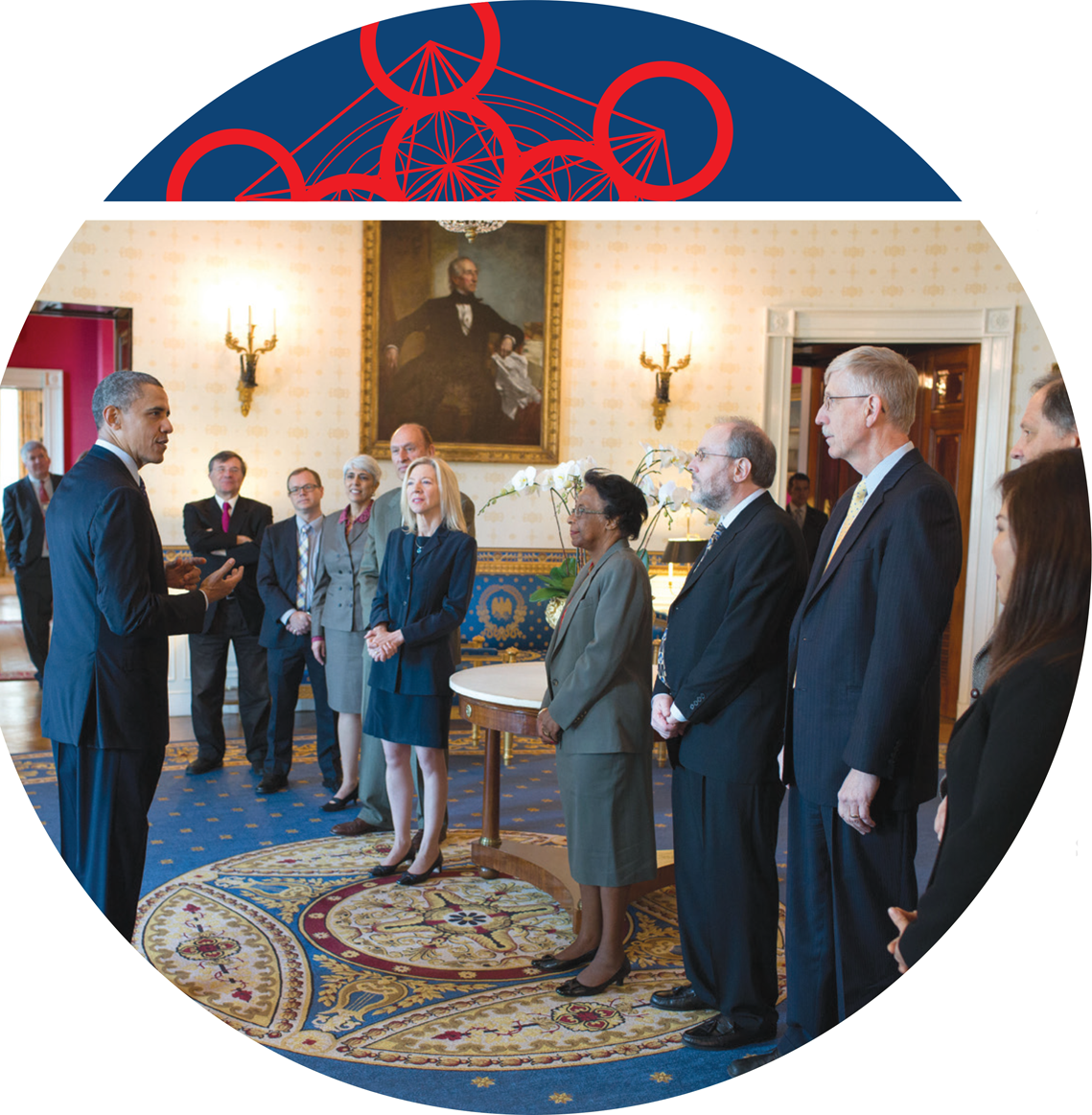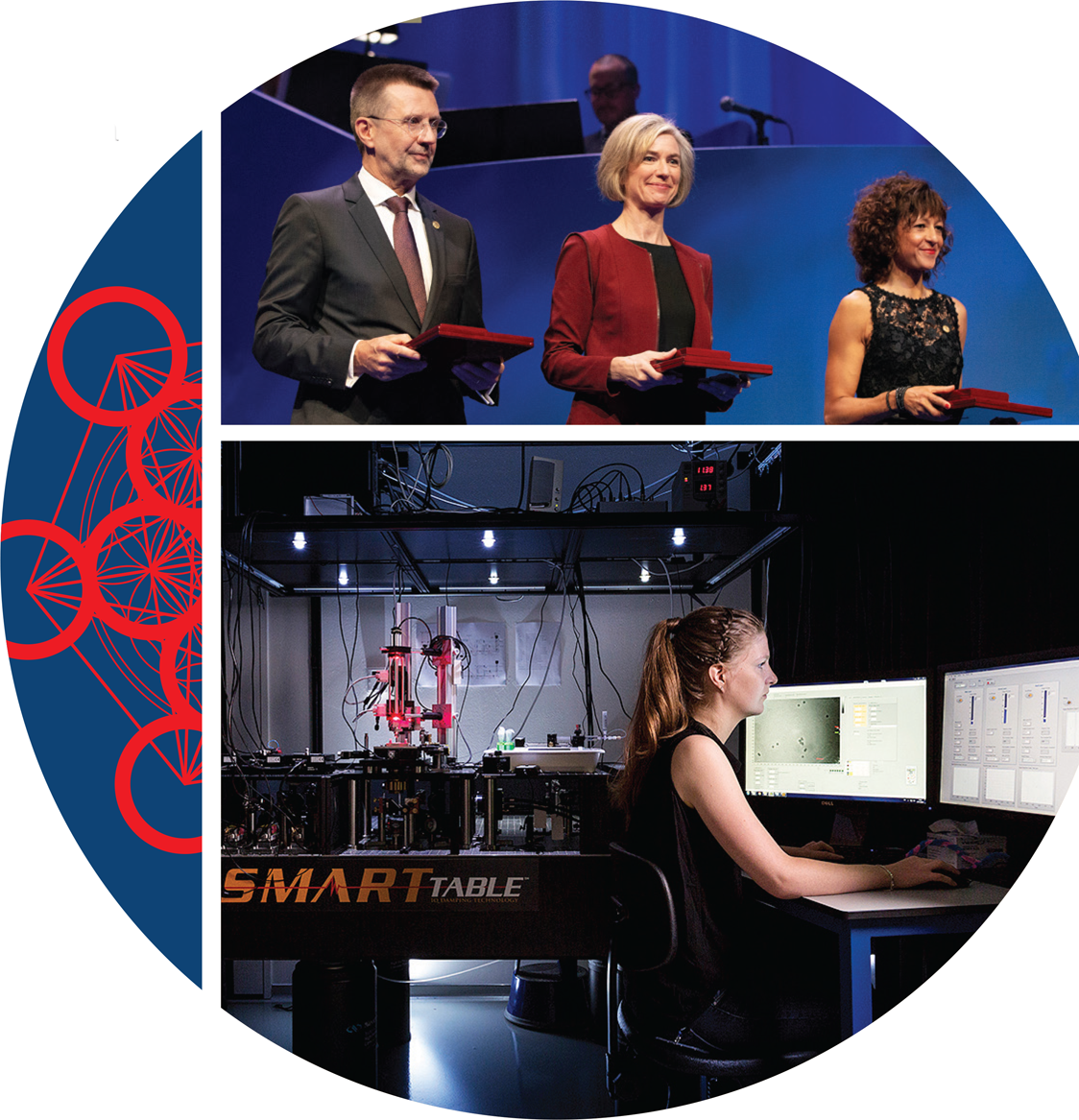“The future will be more spectacular than any of us can imagine.” — Fred Kavli
The Kavli Foundation, established in December 2000, will be celebrating its 20th anniversary next month. Fred Kavli, a Norwegian-born physicist, entrepreneur, business leader, innovator, and philanthropist, started the foundation as a means to advance science for the benefit of humanity. Its mission is implemented through an international program of research institutes, initiatives and symposia, as well as The Kavli Prize, and a program in public engagement with science.
Fred's love of science began as a child growing up on a farm, where he developed a curiosity about nature. This sense of wonder and a desire to do something for the long-range benefit of society is the core of the foundation. He wanted to support basic science by promoting public understanding of scientific research and to support scientists and their work.

Kavli Foundation leadership and partners visit the White House during the announcement of the US BRAIN Initiative in April 2013. Credit: The White House.
He once said, “My goal is to support research at the frontiers of science, to pursue the most far-reaching opportunities, and to seek answers to the most fundamental questions.”
The Materials Research Society (MRS) has been a partner with The Kavli Foundation for more than a decade, and, “It's been extremely productive,” said Bob Conn, president and CEO of The Kavli Foundation. “Approaching the 20th anniversary of The Kavli Foundation, I've had the opportunity to look back as well as to think ahead.”
Foundation's development
Bob identified two key phases in the foundation's development:
During the first decade, the foundation laid out its basic strategic elements: establishing endowed science institutes and establishing The Kavli Prize.
The foundation toward the end of its first decade experienced the impact of the 2007–2009 recession. “I joined the foundation in April 2009, and there were several core strategic pieces already in place, and the foundational bricks had been laid,” said Bob. The foundation had learned that funding basic research through the Kavli Institutes at universities was the most effective and unique way to provide support to science and scientists, and within the first decade, 10 Institutes were established. (Currently, there are 20.)
“The second thing we did in the latter half of the first decade was to give recognition to scientists, especially in the fields of nanoscience, neuroscience, and astrophysics. With the definition of the focus areas and how we were going to put our support in Institutes and endow them, we then established The Kavli Prize as a means to help the public appreciate science and its work,” said Bob. The Kavli Prize was established in 2005, with the first laureates announced in 2008. The laureates are announced every other year in each of the three fields.
“The resources weren't there in the beginning to do more than that, but there were deeply foundational concepts that allowed us to drive ahead. In response to the financial crisis, we made a core strategic decision to engage more broadly and deeply, to become involved with scientific communities at large, including MRS,” Bob added.
“Societies had some unique, unmet needs, and with modest funds, we were able to make an enormous difference. So we met with individual societies to discover their needs and how we could help the most. This led us to go international,” said Bob.
In the second decade, the foundation became much more active and involved in convening meetings on the frontiers of science: “Where science comes together, where people meet, where debate happens, and where steps to the future can be thought about,” said Bob. When Fred passed away in 2013, he left everything to the foundation, which gave it an opportunity to grow. “We had to make a series of truly transformative decisions, such as when and how to invest larger funds towards the foundation's future and how we would set ourselves on a course to achieving greatness in what we do,” said Bob.
Examples of these decisions include increasing the annual budget, embarking on an enhanced, dedicated program of public engagement with science, strengthening the Kavli Institutes globally, and moving the foundation's headquarters to Los Angeles from Oxnard, Calif. It also meant putting more effort toward a newer strategy of convening people to advance science. “This is what we today call catalyzing and enabling science—let's convene people from inside and outside the fields—and it has led to a meetings program we have been quite exceptional at,” added Bob. One of those meetings brought together scientists in neuroscience and nanoscience to talk about how these two fields and their emerging technologies could advance brain research. This initial meeting led to what later became the US BRAIN Initiative, announced by the Obama administration in 2013.
Another important role the foundation played in supporting science was co-founding the Science Philanthropy Alliance in 2012. This is an organization that provides advice and learning opportunities for individual philanthropists and foundation staffs on how to support basic research most effectively. The Alliance began with an initial six foundations and has grown to more than 30, with over a billion dollars directed from private philanthropy to scientific research.
When asked about the third phase, Bob replied, “It's to celebrate the first two decades and recognize that as we are going into the third decade, we have found our place among the most consequential of science foundations. What is unique about what we do in science philanthropy is our endowment model supporting research institutes at great universities and that we are global, and it is these two things that will always differentiate us.”
When asked if moving forward, he anticipated the foundation getting involved in other areas of science, Bob said most likely not. “One of the strengths we've had is choosing well. If you choose well, and the fields you choose have a long future, we don't have a compelling reason to change. To do so would dilute our ability to have an impact on science.”
Kavli Institutes of Nanoscience
The Kavli Foundation has established re-search institutes at leading academic and research institutions worldwide in the fields of astrophysics, nanoscience, neuroscience, and theoretical physics.
The Kavli Nanoscience Institute (KNI) at the California Institute of Tech-nology builds on Caltech's history as a pioneering institution in research at the nanoscale and was the first Kavli Institute in nanoscience. KNI studies the potential application of nanoscience to fields such as biotechnology and photonics. Its faculty roster includes more than 30 Caltech principal investigators representing a wide range of disciplines, from biology and physics to mathematics, chemical engineering, and computation and neural systems. The Institute sponsors workshops, postdoctoral fellowships, and holds frequent colloquia that feature distinguished visiting scientists. Julia R. Greer serves as the KNI director.
The Kavli Institute of Nanoscience at Delft University of Technology, The Netherlands, explores the theoretical and practical frontiers of nanoscience, studying new physics and exploiting novel principles to develop new devices, materials, and methods of fabrication. It is co-directed by Chirlmin Joo and Kobus Kuipers, and has 50 faculty with many doctoral students and postdoctoral fellows. In the early part of the last decade, the Institute began working with Microsoft, and more recently with Intel and other technology leaders to advance quantum computing.

(Top) Left to right, Virginijus Šikšnys, Jennifer Doudna, and Emmanuelle Charpentier receive their medals at The Kavli Prize Ceremony in Oslo, Norway, in September 2018. The 2020 Nobel Prize in Chemistry was awarded to Charpentier and Doudna “for the development of a method for genome editing.” Credit: Fredrik Hagen, The Kavli Prize.
(Bottom) PhD student at the Kavli Institute of Nanoscience Delft utilizes a magnetic tweezers setup, manipulating DNA molecules at the nanoscale. Credit: Kavli Institute of Nanoscience Delft.
The Kavli Institute at Cornell University for Nanoscale Science (KIC) is devoted to the development and utilization of next-generation tools for exploring the nanoscale world. Led by KIC Director Paul McEuen and Co-director David Muller, the Institute is focused on creating new techniques to image and dynamically control nanoscale systems, and using these techniques to push the frontiers of nanoscale science. KIC's membership consists of more than 40 full-time faculty working in partnership with the entire Cornell science and engineering community.
The Kavli Energy NanoSciences Institute (ENSI) at the University of California, Berkeley, and Lawrence Berkeley National Laboratory is a leader in energy research and the measurement and manipulation of matter at the nanoscale. It is dedicated to studying how nature manages energy at the nanoscale and to developing new ways to capture, store, and harness energy for the world's growing population. The Kavli ENSI is led by Director Peidong Yang along with Co-directors Omar Yaghi and Michael Crommie. It brings together 23 world-class scientists from diverse backgrounds, including leading theorists, leaders in characterizing nanostructures, experts in synthesizing materials, and researchers who can combine nanostructures into novel energy devices.
The Kavli Prize
The Kavli Prize recognizes scientists for breakthrough discoveries in three research areas: astrophysics, nanoscience, and neuroscience. They are presented every two years in cooperation and partnership with The Norwegian Academy of Science and Letters and The Norwegian Ministry of Education and Research. The Kavli Prize Laureates are recommended by three independent prize committees comprised of distinguished international scientists recommended by the Chinese Academy of Sciences, the French Academy of Sciences, the Max Planck Society, The Norwegian Academy of Science and Letters, the US National Academy of Sciences, and The Royal Society.
The 2020 Kavli Prize in Nanoscience recognized Harald Rose, Maximilian Haider, Knut Urban, and Ondrej L. Krivanek “for sub-ångström resolution imaging and chemical analysis using electron beams.”
The 2018 Kavli Prize in Nanoscience recognized Emmanuelle Charpentier, Jennifer A. Doudna, and Virginijus Šikšnys “for the invention of CRISP-Cas9, a precise nanotool for editing DNA, causing a revolution in biology, agriculture, and medicine.” “That award broadened everyone's thoughts about nanoscience,” said Bob.
Partnership with MRS
The Kavli Foundation and MRS have had a successful partnership creating the Future of Materials Workshops, which have fostered many intellectual discussions in areas of materials research. The workshop topics emerge from conversations with the scientists themselves. “We tap into where people are feeling is the greatest discovery down the road that we can explore,” said Bob.
The general idea is to have a select group of invited speakers and participants with time interspersed for in-depth discussions. The chairs of the workshops decide the format, select appropriate sub-areas, and invite participants who are experts in these areas. The series has featured:
■ Building a Community for Autonomous Research (2020)
■ Solid-State Materials and Quantum Information (2019)
■ The Brain-Machine Interface (2019)
■ 3D Printing of Biomedical Materials and Devices (2017)
■ Flexible and Stretchable Bioelectronics (2017)
■ Biosensors and Biodiagnostics (2016).
MRS also enjoys the partnership it has regarding the Kavli lectureships at MRS Meetings—The Kavli Foundation Early Career Lectureship in Materials Science and the Plenary Session Featuring The Fred Kavli Distinguished Lectureship in Materials Science—which enhances the quality of its guest speakers. “These lectureships are mutually beneficial because they serve the community and honor Fred. They help us to do the job we need to do in the service of science,” said Bob.
Retirement of Bob Conn
After 12 years of leading The Kavli Foundation, Bob will step down as president and CEO and will retire at the end of this year. He led the foundation through an extraordinary period of growth, one that included a tripling of the endowment after Fred's passing and a tripling of staff. He helped to expand the Kavli Institutes, created new Foundation programs, and elevated the Foundation's reputation and standards as a major philanthropic player in support of basic science.
“Helping science advance and helping the public understand the role and importance of science to their lives has been a special experience. It's been a fantastic run. The partnership we've had with MRS has been one of the joys during these years.”





